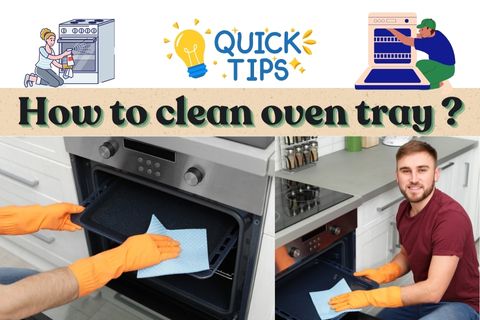Oven trays are an indispensable part of any kitchen, used for everything from roasting meats to baking cookies. However, frequent use can lead them to become coated with baked-on grease, food residues, and stubborn stains. A clean oven tray not only improves the taste of your food but also extends the life of the tray. Here’s a detailed, human-friendly guide to help you achieve sparkling clean oven trays.
Understanding Your Oven Tray
Before diving into the cleaning process, it's important to identify the type of oven tray you have as different materials require different care:
Metal trays including aluminum and stainless steel are common and can generally withstand abrasive scrubbers and harsh chemicals.Non-stick trays require gentle cleaning to avoid damaging the coating.
Glass trays can handle heavy-duty cleaners but are prone to scratching if not handled carefully.
Ceramic trays are sturdy yet they can be susceptible to chipping if scrubbed too vigorously.
Preparing to Clean
Materials Needed:
Baking soda
Vinegar
Dish soap
Sponge or scrubbing brush
Rubber gloves
Paper towels or soft cloth
Plastic scraper or spatula
Initial Cleaning:
Remove debris:
Before applying any cleaning solution, remove any loose crumbs or chunks of food from the tray.
Pre-soak to loosen grime:
Fill your sink or a large tub with hot water mixed with a squirt of dish soap. Submerge the tray for at least 30 minutes to loosen the grease.
Cleaning Methods
Dish soap and water:
After soaking, use a sponge to scrub the tray gently. This method is often enough for trays with light soiling and is safe for most surfaces.
Baking soda paste:
Mix baking soda with water to create a thick paste. Spread this paste over the surface of the tray and let it sit for at least 30 minutes. Scrub with a sponge or brush, then rinse thoroughly.
Vinegar and baking soda:
Sprinkle baking soda over the tray, then spray or pour vinegar over it. The combination will fizz and help break down tough stains. Allow the mixture to work for 30 minutes before scrubbing.
Oven cleaner:
For extremely stubborn stains, commercial oven cleaners can be effective. Be sure to wear gloves and ventilate the area well. Follow the manufacturer’s instructions for application and removal.
Ammonia for overnight soaking:
If stains persist, placing a small dish of ammonia inside a closed oven (turned off) with the trays can help loosen the grime overnight. Ensure the room is well-ventilated.
Aftercare and Maintenance
Rinsing and Drying:
After cleaning, rinse the oven trays thoroughly with clean water to remove any residual cleaner. Dry completely with a soft cloth or paper towels to prevent rust on metal trays.
Use liners:
Using aluminum foil or parchment paper as a liner can reduce contact between the food and the tray, making cleanup easier.
Immediate cleaning:
Clean trays as soon as they cool down to prevent grease and food residues from hardening.
Regular Maintenance:
Incorporate a regular cleaning routine for your oven trays. Immediately addressing spills and splatters after each use can prevent the buildup of grime and make deep cleaning less frequently necessary.
Conclusion
Keeping your oven trays clean is not just about aesthetics; it also contributes to the functionality and hygiene of your cooking environment. Whether your trays need a quick wash or a deep clean, understanding the proper techniques and materials will help you maintain them in top condition. With the right care, your oven trays can remain a spotless and valuable kitchen tool for years to come.
Feel free to adjust the complexity of the cleaning methods based on the severity of the dirt and grime on your trays. Happy cleaning!




